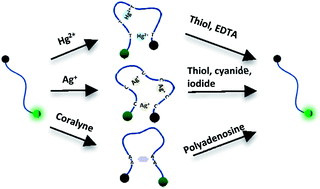Design of two and three input molecular logic gates using non-Watson–Crick base pairing-based molecular beacons†
Abstract
This study presents a single, resettable, and sensitive molecular beacon (MB) used to operate molecular-scale logic gates. The MB consists of a random DNA sequence, a fluorophore at the 5′-end, and a quencher at the 3′-end. The presence of Hg2+, Ag+, and coralyne promoted the formation of stable T–Hg2+–T, C–Ag+–C, and A2–coralyne–A2 coordination in the MB probe, respectively, thereby driving its conformational change. The metal ion or small molecule-mediated coordination of mismatched DNA brought the fluorophore and the quencher into close proximity, resulting in collisional quenching of fluorescence between the two organic dyes. Because thiol can bind Hg2+ and remove it from the T–Hg2+–T-based MB, adding thiol to a solution of the T–Hg2+–T-based MB allowed the fluorophore and the quencher to be widely separated. A similar phenomenon was observed when replacing Hg2+ with Ag+. Because Ag+ strongly binds to iodide, cyanide, and cysteine, they were capable of removing Ag+ from the C–Ag+–C-based MB, restoring the fluorescence of the MB. Moreover, the fluorescence of the A2–coralyne–A2-based MB could be switched on by adding polyadenosine. Using these analytes as inputs and the MB as a signal transducer, we successfully developed a series of two-input, three-input, and set–reset logic gates at the molecular level.


 Please wait while we load your content...
Please wait while we load your content...